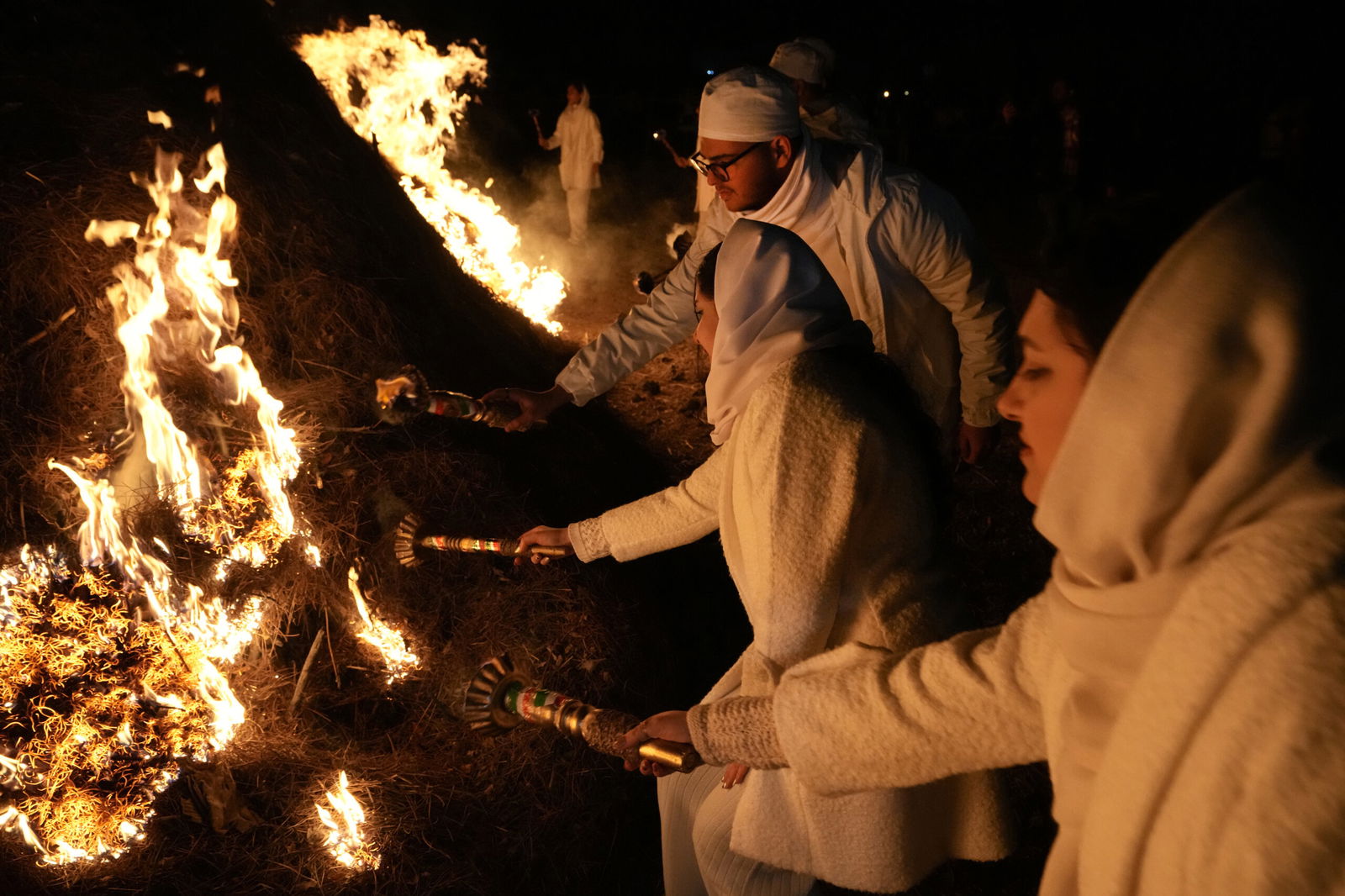Around the World briefs

By Associated Press
With bonfires and hope, Iran’s minority Zoroastrians celebrate Sadeh and the end of cold winter days
TEHRAN, Iran | Lighting fires that brightened the night sky, followers of Iran’s minority Zoroastrian religion marked the Sadeh festival in several cities, celebrating the end of the coldest winter days.
Every year on Jan. 30, Zoroastrians gather after sunset to celebrate the 50 days and 50 nights remaining to Spring. Sadah, which means “the one hundred,” is an ancient feast from when the religion was the dominant faith in the powerful Persian empire, which collapsed after the Arab invasion in the 7th century.
On the southwestern outskirts of Tehran Tuesday evening, several Zoroastrian priests and priestesses, dressed in white from head-to-toe to symbolize purity, led young followers to light a giant bonfire in a joyful ceremony.
Around the fire, people listened to bands playing music, theological lectures as they milled about eating and celebrating.
In a rare move, the Islamic Republic’s air force band played the national anthem among other tunes to the excitement of the attendees.
Iran’s 85-plus million population are mostly Shiite Muslims. The country has been ruled by hard-line clerics who preach a strict version of Islam since the 1979 Islamic revolution, who discouraged people from following pre-Islamic feasts and traditions.
Zoroastrianism is a monotheistic religion that predates Christianity and Islam. It was founded some 3,800 years ago by the prophet Zoroaster. It stresses good deeds, and fire plays a central role in worship as a symbol of truth and the spirit of God. Zoroastrians stress they are not fire-worshippers, but see fire as a symbol of righteousness.
Alongside other minorities, including Christians and Jews, they have one representative in parliament, Esfandiar Ekhtiari.
During Tuesday’s ceremony, Ekhtiari said the celebration belongs to everyone and is a symbol of “felicity, respect to humanity and nature as well as human beings .”
In 2023, UNESCO recognized Sadeh in its Intangible Cultural Heritage of Humanity from Iran and Tajikistan.
Though they have common elements such as lighting fire, the Sadeh festival is different from Nowruz which marks the Persian new year.
Nearly 400 Ethiopians have died
of starvation recently. Millions
more need food aid
KAMPALA, Uganda | Nearly 400 people have died of starvation in Ethiopia’s Tigray and Amhara regions in recent months, the national ombudsman said Tuesday, a rare admission of hunger-related deaths by a federal body.
Local officials have previously reported starvation deaths in their districts, but Ethiopia’s federal government has insisted these reports are “completely wrong”.
Ethiopia’s ombudsman office sent experts to the regions, which are gripped by drought and still reeling from a devastating civil war that officially ended 14 months ago. They concluded that 351 people have died of hunger in Tigray in the past six months, with 44 more deaths in Amhara.
Only a small fraction of needy people in Tigray are receiving food aid, according to an aid memo seen by The Associated Press, more than one month after aid agencies resumed deliveries of grain following a lengthy pause over theft.
Just 14% of 3.2 million people targeted for food aid by humanitarian agencies in Tigray this month had received it by Jan. 21, according to the memo by the Tigray Food Cluster, a group of aid agencies co-chaired by the U.N.’s World Food Program and Ethiopian officials.
The memo urges humanitarian groups to “immediately scale up” their operations, warning that “failure to take swift action now will result in severe food insecurity and malnutrition during the lean season, with possible loss of the most vulnerable children and women in the region.”
The U.N. and the U.S. paused food aid to Tigray in mid-March last year after discovering a “large-scale” scheme to steal humanitarian grain. The suspension was rolled out to the rest of Ethiopia in June. U.S. officials believe the theft may be the biggest diversion of grain ever. Donors have blamed Ethiopian government officials and the military for the fraud.
The U.N. and the U.S. lifted the pause in December after introducing reforms to curb theft, but Tigray authorities say food is not reaching those who need it.
Two aid workers told the AP that the new system — which includes fitting GPS trackers to food trucks and putting QR codes on ration cards — has been hampered by technical issues. Aid agencies are also struggling with a lack of funds.
A third aid worker said the food aid pause and the slow resumption meant some people in Tigray have not received food aid for over a year. “They went through multiple rounds of registration and verification, but no actual distributions yet,” the aid worker said.
The aid workers spoke to the AP on the condition of anonymity because they were not authorized to speak to the press.
Around 20.1 million people across Ethiopia need humanitarian food due to drought, conflict and a tanking economy. The aid pause pushed up hunger levels even further.
The U.S.-funded Famine Early Warning System has warned that crisis levels of hunger or worse “are expected in northern, southern and southeastern Ethiopia throughout at least early 2024.” A former head of the WFP has described these levels of hunger as “marching towards starvation.”
In Amhara, which shares a border with Tigray, a rebellion that erupted in August is impeding humanitarians’ movements and making distributions difficult, while several regions of Ethiopia have been devastated by a multi-year drought.
Malnutrition rates among children in parts of Ethiopia’s Afar, Amhara and Oromia regions range between 15.9% and 47%, according to a presentation by the Ethiopia Nutrition Cluster and reviewed by the AP. Among displaced children in Tigray, the rate is 26.5%. The Ethiopia Nutrition Cluster is co-chaired by the U.N. Children’s Fund and the federal government.
Tigray, home to 5.5 million people, was the center of a devastating two-year civil war that killed hundreds of thousands and spilled into the neighboring regions. A U.N. panel accused Ethiopia’s government of using “starvation as a method of warfare” by restricting food aid to Tigray during the conflict, which ended in November 2022 with a peace deal.
Persistent insecurity meant only 49% of Tigray’s farmland was planted during the main planting season last year, according to an assessment by U.N. agencies, NGOs and the regional authorities, and seen by the AP.
Crop production in these areas was only 37% of the expected total because of drought. In some areas the proportion was as low as 2%.
The poor harvest prompted Tigray’s authorities to warn of an “unfolding famine” that could match the disaster of 1984-5, which killed hundreds of thousands of people across northern Ethiopia, unless the aid response is immediately scaled up.
But Ethiopia’s federal government denies there is a large hunger crisis. When Tigray’s leader, Getachew Reda, raised the alarm over looming mass starvation deaths last month, a federal government spokesperson dismissed the reports as “inaccurate” and accused him of “politicizing the crisis.”
An auction of Nelson Mandela’s possessions is suspended as South Africa fights to keep them
JOHANNESBURG | The planned auction of dozens of artifacts belonging to Nelson Mandela has been suspended pending a court application to completely halt it, the body that protects South Africa’s cultural heritage said Tuesday.
The online auction had been scheduled by New York-based Guernsey’s auction house on Feb. 24, in conjunction with Dr Makaziwe Mandela, the eldest daughter of the anti-apartheid icon and South Africa’s first democratically elected president who died in 2013.
It had received widespread criticism from the public and the South African government, which is supporting a court application by the South African Heritage Resources Agency, or SAHRA, to appeal an earlier court judgment that gave the auction the go-ahead.
Items listed for the auction include Mandela’s iconic Ray-Ban sunglasses and “Madiba” shirts, personal letters he wrote from prison, as well as a blanket gifted to him by former U.S. President Barack Obama and his wife Michelle.
A champagne cooler that was a present from former U.S. President Bill Clinton was also on the list, with bidding for it starting at $24,000. Also among the items is Mandela’s “book” — his identification document following his 1993 release from prison.
On its website, Guernsey’s described the planned auction as “nothing short of remarkable,” and said that proceeds would be used for the building of the Mandela Memorial Garden in Qunu, the village where he is buried.
A note on the auctioneers’ website on Tuesday indicated that the auction had been suspended without providing any further details.
SAHRA said in statement that the suspension is a result of its engagement with Dr. Mandela and the auction house.
“SAHRA welcomes the decision by Guernsey’s Auction House to suspend the auction,” the agency said.
The agency is awaiting the outcome of an application for leave to appeal the decision by the North Gauteng High Court in Pretoria to let the auction go ahead, dismissing an interdict by the agency in December last year.
The agency argues that the items to be auctioned are the country’s cultural heritage artifacts and should be preserved for future generations instead of being sold to the highest bidder.
Poland’s new government asks Germany to think creatively about compensation for World War II losses
BERLIN, Germany | The foreign minister in Poland’s new pro-European Union government said Tuesday he would like Germany’s leaders to think in a “creative” way about compensating Poland for huge losses it suffered at German hands during World War II.
The request was greatly toned down from that of Poland’s previous right-wing government, which had demanded $1.3 trillion in reparations for Nazi Germany’s invasion and occupation in 1939-45.
German officials have consistently said that while Berlin recognizes its historical responsibility, the issue of reparations was settled decades ago.
Foreign Minister Radek Sikorski spoke at a joint news conference with German Foreign Minister Annalena Baerbock in Berlin before their talks on improving bilateral relations that were strained under Poland’s previous government.
“I will also ask the minister (to make) the German government think in a creative way about finding a form of compensation for these war losses, or of redress,” Sikorski said when talking about a project in Berlin to memorialize Poland’s suffering.
He did not give details.
Baerbock said that “confronting the suffering of millions (of people) that Germany brought on Poland remains a task for ever.” She didn’t address calls for reparations.
A nation of some 31 million in 1939, Poland lost some 6 million of its citizens, half of them Jewish, during Nazi wartime occupation. It also suffered enormous damage to its industry, infrastructure and cultural heritage.
Germany has been insisting the matter of reparations was closed by decisions taken during communist times, when Warsaw relinquished seeking reparations. Poland stresses it was under the domination of the Soviet Union at that time, so the declaration was made under Moscow’s pressure and was not legally binding.
—From AP reports



